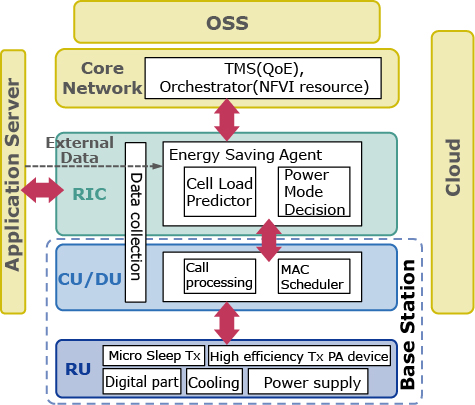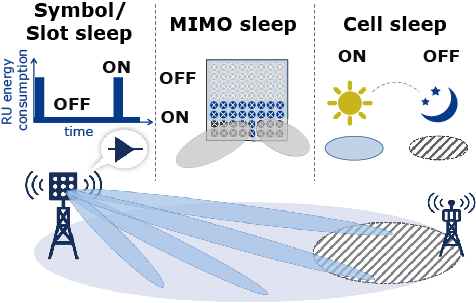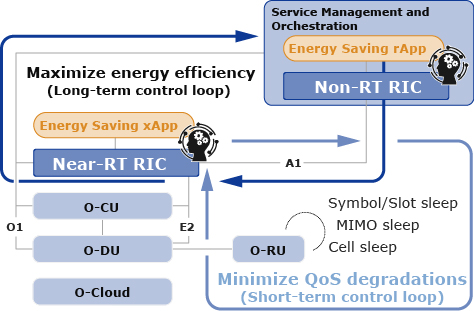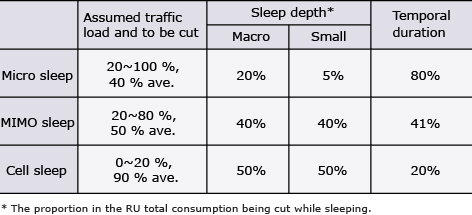Global Site
Displaying present location in the site.
NEC’s Energy Efficient Technologies Development for 5G and Beyond Base Stations toward Green Society
Vol.17 No.1 September 2023 Special Issue on Open Network Technologies — Network Technologies and Advanced Solutions at the Heart of an Open and Green SocietyNEC has one hundred and twenty-three years experiences and is maintaining the leading position in the networks and telecom radio technologies area. Now, NEC is one of the global frontier of O-RAN based mobile infrastructure equipment and network vendor. This paper introduces the NEC’s energy saving technologies development activities through the end to end O-RAN system which provide the operational benefits for the mobile operators and society by minimizing the energy consumption and carbon emission simultaneously responding to the explosive traffic demand growth with guarantee the user experienced QoS. In addition with a typical system configuration for the coverage assuming Japan island metro area, the estimated annual consumption reduction and OPEX cut and the carbon emission reduction using the proposed technologies have been shown as an example.
1. Introduction
In responding to rapidly increasing mobile traffic, several innovative technologies have been developed and have been commercialized in the 5th generation mobile access (5G) network. The mobile access technologies have been enabling the remoteness of several kinds of human senses such as voice, vision and now kinematics and prediction. But we have to note the convenience are based on the energy hungry technologies.
Recently, the 3rd generation partnership project (3GPP) Radio Access Network (RAN) approved its work package for Release 18 which will mark the start of 5G Advanced. It will study and identify possible techniques to improve network energy efficiency, which may include dynamically and/or semi-statically of network energy saving in time, frequency, spatial and power domain1). Now NEC is a major contributor to their studies.
The massive multiple input and multiple output (Massive MIMO) technology is developed and is introduced in 5G for the further capacity enhancement by the spatial division multiple access additionally to the historic multiple access of time-division (TDD) , code-division and orthogonal frequency division. We can note the Massive MIMO has also ability to save the energy by serving the radio wave to where and when they are necessity thanks to beam-forming technologies, associate with Radio Intelligent Controller (RIC).
Because of the responsibility to maintain the earth’s environment and pass it over to future generations as a positive inheritances, NEC is continuing the research and development of the energy saving technologies simultaneously with the performance enhancement technologies. Fig. 1 shows the typical block diagram of a 5G system consist of RAN Intelligent Controller (RIC), Core Network (CN) and Operation Support System (OSS), Central Unit (CU), Distributed Unit (DU) and Radio Unit (RU) which are discussed in this paper.

2. Energy Efficient Technologies
2.1 Radio Units, RF Devices and Technologies
The RU, especially the RF Power Amplifiers (PA) are the major source of the base station’s energy consumption.
Today, the GaN HEMT became the major stream of PA devices technologies successions of the Si based lateral diffusion MOS FET (LDMOS) which were popular in previous generation mobile access systems. The GaN HEMT potentially exhibit high power efficiency because of their high Baliga FOM, but they also have several kinds instability issued mostly coming from the unexpected charge traps, and they impacts the signal quality in especially TDD transient operation. NEC has the research activities and academic reviewed analysis of their impacts to the radio performances and countermeasure2)3), and their application to the high efficiency Doherty Amplifiers4).
Doherty is one of enhancement from traditional class-B amplifier using the load modulation technique basically consists of main amplifiers for average signal and auxiliary amplifiers for peak signal for the higher peak to average power ratio (PAPR) modulated signal. The Class-B amplifier consumption current is proportional to the square root of output power. This means PA still consume the surplus current at larger back-off and/or no signal conditions. Micro sleep technology cuts the quiescent current which consumes a certain amount of PA when there is no traffic.
The details sleep management are described in the following subsections.
2.2 QoS-Aware Sleep Mode Controlling
The RU sleep mode must be performed in a way which ensures user experience taking into account the impact on QoS under the condition that the traffic load in a cell varies spatially and temporally. NEC’s solution provides the maximum power saving effect while guaranteeing the user experienced QoS. RIC dynamically controls the three sleep modes optimal for each cell while taking into account the fluctuation of the traffic load of each cell and QoS. Fig. 2 shows the three sleep mode features in RU.

Micro (Symbol/Slot) sleep feature turns off the PA to shut the quiescent current down at symbol/slot-duration basis during a period when there is no control signal nor user data to transmit. Micro sleep is one effective means of cutting the surplus consumption.
MIMO sleep feature turns off a sub-set of transmitters in the RU that uses several RF channels to support MIMO or Massive MIMO. By adjusting the number of transmitters to turn off, this feature can strike a good balance between the RU energy consumption and the coverage and capacity in a cell to maintain QoS.
Cell sleep feature turns off PA and digital circuits in RU during low-traffic hours, such as at midnight. Typically, this feature is applied to a capacity cell overlaid on coverage cells. It offloads the traffic in the capacity cell to the neighboring coverage cells before activating the cell sleep in order to maintain QoS.
2.3 Virtualized RAN and Intelligent Controller
AI technologies enables network operators to automate fine-grained optimization of energy saving. RIC offers the features that enable a base station to integrate AI technologies with the radio control. RIC provides AI-based control capabilities for RAN nodes through Non-RT RIC and Near-RT RIC, as depicted in Fig. 3. For example, Non-RT RIC collects the past traffic data from CU/DU via the O1 interface in the long-term control loop (1 second~). An rApp running on Non-RT RIC predicts the traffic load and determines the optimum sleep mode using AI. The control instruction is sent to CU/DU via the O1 interface, then transferred to RU. Reinforcement learning will model the relationship between the radio control settings of a base station and achievable KPIs in a cell. With this model, the optimization feature can automate the determination of the optimum radio control settings to meet the KPI requirements such as the acceptable upper limit of energy consumption.

Cooperating with Near-RT RIC via the E2 interface, the base station can apply the optimum sleep mode in the short-term control loop (10 msec ~ 1 sec). It enables the quick recovery from the QoS degradations due to the sleep control. For example, xApp running on Near-RT RIC collects QoS-related KPI data from CU/DU. Receiving the QoS requirements from Non-RT RIC via the A1 interface, the xApp detects QoS degradations and takes care of them by switching to another sleep mode when necessary. RIC enables the base station to automatically apply more energy-efficient sleep for a longer period. Near-RT RIC short-term loop with AI can minimize the risk of serious QoS degradations due to unexpected traffic demands or temporal degradations of radio quality. With this solutions, network operators can continue to enhance the energy efficiency while improving the AI algorithms of rApp/xApp based on the operation experienced data.
2.4 Core Network
NEC is promoting energy saving efforts not only RAN network functions but also 5G Core (5GC) network functions in Core Network. NEC's 5GC network functions are virtualization and cloud-native software designed to work in both on-premises and public cloud environments, and are implemented with multicore architectures in mind. By virtualizing network functions, Hardware resources (CPU, Memory, etc.) can be effectively used by separating Hardware and Software, and further performance improvement and low power consumption can be expected by utilizing the latest Hardware.
2.5 System level Optimization
NEC is proceeding with research and development to optimize the entire telecommunications network system.
We are providing an Orchestrator for End-to-End and each RAN/TN/CN domain, which provides functions of automate and optimize network operations. They will cut the operators labor cost and optimize energy consumption.
For virtualized network systems, we will continue to develop software products optimized for the latest CPU architecture while evaluating server power performance (data transfer performance per power) by following up on the next generation CPU processors from Intel, ARM, and AMD. In particular, for U-Plane applications such as UPF, CU-UP, and DU, in order to achieve both high performance and low power consumption, we will promote the commercialization not only by us, but also by the ecosystem as a whole by creating jointly with leading device (including hardware accelerator like FPGA and SmartNIC) vendors5)6), COTS server vendors, virtualized platform vendors, hyperscaler cloud service providers, etc.
3. Operational Benefits
In summarizing the energy saving efforts of the RU sleeps and the server level power optimization described in section 2, there can be calculated the energy saving of 6.8 MW/hour in case of covering 110,000 km2 land area by 36,000 units of sub6 GHz 64T64R Massive MIMO RU with their EIRP of 70 dBm and the cell radius of 1 km. The area corresponds to the urban of Japan. And assumed traffic conditions, sleep depths and durations are shown in Table, which are roughly determined considering the actual traffic data7).
Table Assumed Traffic, Sleep Depths and Durations.

Additionally in assuming the power rate of 0.2 $/kW・hour, its annual OPEX saving is roughly 12 $M/year.
By using the typical carbon emission coefficient of 0.000453 t CO2/kW・hour7), the annual carbon emission reduction for above scenario is 27000 t CO2/year.
4. Conclusion
NEC continues the research and development of energy saving technologies to maintain the earth’s environment green and intends to pass it over to future generations as a positive inheritances.
There are the RF technologies development to enhance the network capacity using higher frequencies8) and the novel distributed MIMO technologies9)10), and further exploring the end-to-end intelligent control technologies of 5G systems. Especially in use of AI services, NEC’s online reinforcement learning technologies under research will enable the 5G systems to apply the configuration policies to achieve the optimal balance between the power consumption and the service performance automatically11)12).
References
- 1)
- 2)
- 3)
- 4)
- 5)
- 6)
- 7)
- 8)
- 9)
- 10)
- 11)
- 12)
Authors’ Profiles
Telecom Carrier Software Development Department
Professional
Mobile Radio Access Network Department
Assistant Manager
BSS/OSS Department
Assistant Manager
BSS/OSS Department
Director
Mobile Core Department
Director
Wireless Access Development Department
Executive Standardization Professional
Global Mobile Solution Department
Professional
Global Mobile Solution Department
Director
Telecom Carrier Software Development Department
Senior Professional
Telecom Carrier Software Development Department
Senior Professional
Wireless Access Development Department
 PDF
PDF 3GPP RAN: RP-221443 Study on network energy savings [Online]. Available:
3GPP RAN: RP-221443 Study on network energy savings [Online]. Available: Y. Murao, M. Hayakawa, K. Ohgami and T. Kaneko: A Study of GaN HEMTs Current Collapse Impacts on Doherty Multistage PA Linearity, 2015 IEEE Compound Semiconductor Integrated Circuit Symposium (CSICS), 2015
Y. Murao, M. Hayakawa, K. Ohgami and T. Kaneko: A Study of GaN HEMTs Current Collapse Impacts on Doherty Multistage PA Linearity, 2015 IEEE Compound Semiconductor Integrated Circuit Symposium (CSICS), 2015
